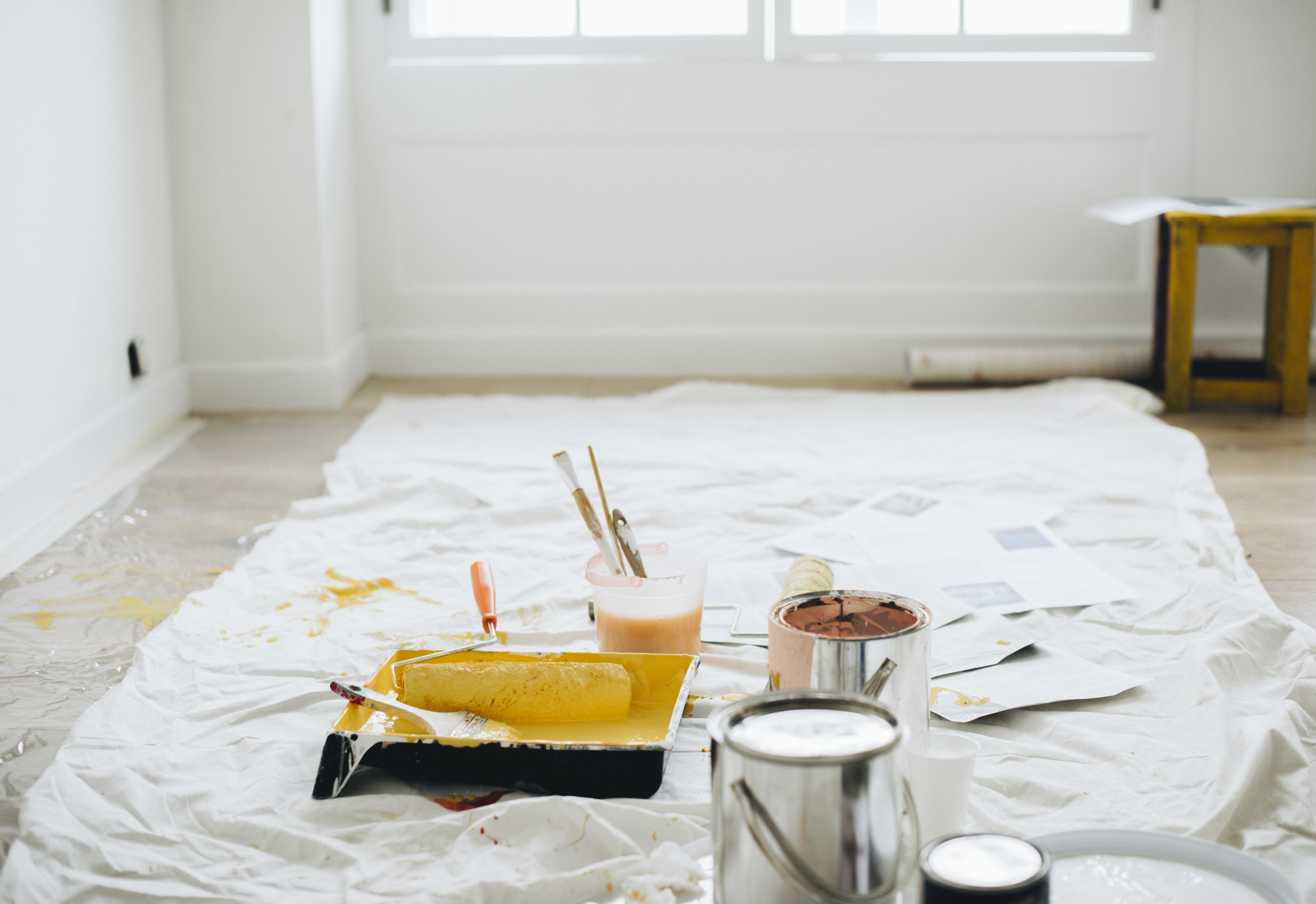Blogs

How Often Should You Repaint Your House Interior?
The lifespan of interior paint depends less on the quality of the application and more on the room's function and the activity level within your household. While high-quality paint can technically last over a decade, maintenance and aesthetic considerations often necessitate refreshing the surfaces much sooner. Knowing the optimal repaint schedule for each room can help you maintain a beautiful, protective, and fresh-looking home.
Why Interior Paint Needs Refreshing
Interior paint does not endure the harsh elements like exterior paint, but it faces constant wear from human activity, lighting, and environmental factors inside the home.
Fading, Scuffs, and Humidity Damage
Mechanical Damage: Scuff marks, dings, and surface abrasion from furniture, shoes, and daily traffic are the most common causes of deterioration. Paint in high-traffic areas quickly shows these signs of wear.
Color Fading: Even indoors, paint is susceptible to UV degradation. Walls exposed to direct or indirect sunlight near windows will slowly fade or yellow over time, making a noticeable difference when compared to a protected area or when moving wall decor.
Moisture and Humidity: Kitchens and bathrooms deal with cycles of steam, condensation, grease splatter, and high humidity. This moisture can compromise the paint film, leading to premature peeling, blistering, and the potential for mildew or mold growth, especially in corners and behind fixtures.
Lifestyle and Household Activity Level
The general rule is: the more activity, the sooner you need to repaint.
High-Traffic Homes: Households with young children, multiple pets, or frequent entertaining will see paint degradation accelerate. Fingerprints, pet rub marks, and general wear and tear on walls and baseboards require more frequent touch-ups or complete repainting to maintain a clean appearance.
Low-Traffic Homes: Spaces rarely used, such as guest rooms, home offices, or formal dining rooms, may only need repainting every 7 to 10 years, assuming the paint finish was durable and of high quality upon initial application.
Room-by-Room Repainting Guide
The following timelines reflect the average frequency required to keep specific rooms looking fresh and clean, based on their typical function and exposure to wear.
Living Room and Bedrooms – Every 5–7 Years
These are considered low- to moderate-traffic areas. The paint typically lasts longer because:
Controlled Environment: They have stable temperature and humidity levels.
Minimal Impact: Walls rarely face direct scrubbing, grease, or high moisture.
Reason for Repaint: Most repaints in these areas are driven by changing aesthetic preferences, the desire to follow color trends, or noticeable fading near windows rather than structural paint failure.
Kitchen and Bathroom – Every 3–4 Years
These are high-moisture, high-splatter zones, demanding the most durable paint finishes and the shortest repaint cycles.
Kitchen: Paint must withstand cleaning chemicals, grease buildup, and steam. Failure to repaint or use the correct sheen can lead to difficult-to-clean walls and rapid deterioration around the stove and sink areas.
Bathroom: Constant exposure to condensation requires a paint with high mold and mildew resistance and a semi-gloss or high-gloss finish to prevent water penetration and allow for frequent washing. The constant stress on the film justifies a shorter lifespan.
Hallways and Trim – Every 2–3 Years
These areas receive the highest concentration of physical abuse and impact.
Hallways: The walls, especially near corners and along staircase walls, are constantly brushed against, scuffed by bags, and marked by hands. These areas show dirt and damage the fastest.
Doors and Trim (Baseboards/Casings): Baseboards are routinely hit by vacuums, mopped floors, and furniture. Door frames are subject to friction and oils from hands. Because they are typically painted with a bright white semi-gloss finish, every scuff, chip, or yellowing mark is highly noticeable, making frequent touch-ups or repainting necessary.
Signs It’s Time to Repaint
Sometimes, the condition of the paint itself will override any suggested timeline. Be proactive and look for these common indicators.
Peeling, Cracks, or Color Dullness
Flaking and Peeling: This is a definitive sign of paint failure, often caused by poor surface preparation during the previous job or prolonged moisture exposure (especially near windows, tubs, or ceilings). When paint peels, it exposes the substrate to moisture and requires immediate attention to prevent structural damage.
Cracking (Alligatoring/Checking): When the paint film looks like dried, cracked mud, it indicates an issue with the underlying material (putty or plaster cracking) or poor paint elasticity.
Color Dullness: If the color appears lifeless, chalky, or significantly darker/lighter than when it was originally applied, it’s a sign that the pigment has degraded or that too many abrasive cleanings have dulled the protective sheen layer.
New Décor or Lighting Changes
Aesthetics are often the strongest driver for a repaint project.
Home Staging/Selling: A fresh, neutral coat of paint is the single most cost-effective way to prepare a home for the real estate market.
New Flooring or Furniture: Repainting is often necessary to ensure the existing wall color complements new, large design elements like cabinetry, tile, or furniture that introduce different undertones.
Switching Lighting: Changing from warm incandescent bulbs to cool, daylight-temperature LED lighting can drastically alter how existing colors appear, making an old color look too yellow, green, or muddy. A fresh coat is necessary to calibrate the color for the new light source.
How to Extend the Life of Interior Paint
The two most effective ways to maximize the time between major painting projects are product selection and consistent, gentle maintenance.
Use Washable Paint Finishes
The sheen (gloss level) of the paint directly correlates with its durability and scrub-ability.
Flat/Matte: Hides surface imperfections beautifully but is the least durable and hardest to clean. Best for low-impact ceilings and formal rooms.
Eggshell/Satin: The most common choices for walls. They offer a modest sheen that resists light wear and can be gently wiped down. This finish provides the best balance of aesthetics and durability for living areas and bedrooms.
Semi-Gloss/Gloss: Highly durable, moisture-resistant, and washable. Mandatory for trim, doors, bathrooms, and high-wear areas like laundry rooms and kitchens.
Regular Cleaning with Gentle Products
Avoid using abrasive sponges, pads, or highly concentrated chemical cleaners on your walls, as these will permanently damage the paint film, regardless of the sheen.
Routine Dusting: Use a soft cloth or a vacuum brush attachment to remove dust from walls and baseboards every few weeks.
Spot Cleaning: Use a mixture of warm water and a few drops of mild dish soap. Use a soft, non-abrasive microfiber cloth to gently clean scuffs and marks. Always rinse the area with a cloth dampened only with plain water afterward to prevent soap residue buildup.
FAQs
Should ceilings be repainted as often as walls?
No, ceilings typically do not need to be repainted as frequently as walls. Since ceilings do not experience physical wear (scuffs, furniture rub), they can often last $10$ to $15$ years. The primary reasons for repainting a ceiling are yellowing from smoke or humidity, noticeable water stains, or a strong desire to brighten the room.
What’s the most durable interior paint finish?
The most durable interior paint finish is High-Gloss. Its dense, smooth surface is impermeable to moisture and is highly resistant to staining and scrubbing. However, high-gloss also highlights every minor imperfection on the wall or trim. For standard high-traffic walls, Semi-Gloss or premium Satin finishes provide the best blend of durability, washability, and aesthetic appeal.
Is your home due for a refresh, or are you preparing to tackle a high-traffic area like a hallway or kitchen? Don't settle for faded or worn paint.
Contact Masterpiece Painter today for an expert consultation. We help you choose the ideal, durable finish for every room in your house and deliver a flawless, long-lasting result.
About Masterpiece Painter
For over 17 years Masterpiece Painter, has been serving communities all around New England. Let us help you make your wishes come true by turning your property into a Masterpiece
Get a Quote

© copyright 2023 All Rights Reserved.



